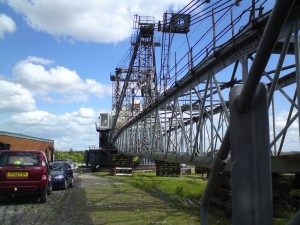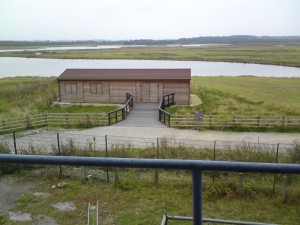History of our BE 1150-B
Large walking draglines (ie over 1000 tons in weight) did not come in to use in Britain until after the Second World War. The first, a BE 1150-B, was imported for use by Sir Lindsay Parkinson & Co. for their opencast coal site at Ewart Hill, Northumberland, and was operational in late 1948. Following this, in 1953-4 three more secondhand BE 1150-Bs were brought to Britain from the USA for opencast coal work, and a further one for ironstone work at Corby, making 5 BE 1150-Bs in Britain in total.
 The St Aidans BE 1150-B is one of the batch of three; it left the factory in South Milwaukee, Wisconsin (identified as B-E No. 47858) on 30th December 1948 and started work in 1949 for the company A E Dick Construction at Phillipi, West Virginia, where it worked for four years before coming to Britain. It worked first at Tirpentwys opencast site near Pontypool from 1954 until 1963. Unlike the other three BE 1150-Bs working on opencast sites in Britain (which had electrical equipment by Westinghouse) our dragline had electrical equipment built by General Electric and was consequently known as “Oddball”. In 1963 Oddball was dismantled at Tirpentwys and transferred to the Poplars site near Cannock, Staffordshire, where it worked from 1964 to 1972. It was dismantled and moved again to start work in 1974 at its final site at St Aidans where it worked until the site became inundated by the flood of March 1988.
The St Aidans BE 1150-B is one of the batch of three; it left the factory in South Milwaukee, Wisconsin (identified as B-E No. 47858) on 30th December 1948 and started work in 1949 for the company A E Dick Construction at Phillipi, West Virginia, where it worked for four years before coming to Britain. It worked first at Tirpentwys opencast site near Pontypool from 1954 until 1963. Unlike the other three BE 1150-Bs working on opencast sites in Britain (which had electrical equipment by Westinghouse) our dragline had electrical equipment built by General Electric and was consequently known as “Oddball”. In 1963 Oddball was dismantled at Tirpentwys and transferred to the Poplars site near Cannock, Staffordshire, where it worked from 1964 to 1972. It was dismantled and moved again to start work in 1974 at its final site at St Aidans where it worked until the site became inundated by the flood of March 1988.
The flooding of the St Aidans open cast coal mining site on Saturday 19 March 1988
Short stretches of the River Aire had been diverted prior to digging for the six million tons of coal. The decision had been taken by the NCB back in 1981 that it was safe to dig up to 50m from the river. The bank had been protected along both the new stretches and the stretches of undiverted river with sheet steel piles 10m long driven down to the bedrock. By March 1988 the excavation which was 58m (about 170 feet) deep had approached to about 130m from the river.

At a routine inspection at 6:10 am on 19 March 1988 it was realised that something was wrong. There had been a landslip in the wall of the excavation and water was entering the site at the top of one of the coal seams down in the excavation. This developed so that by 11:00 am water was flowing in bulk under the piling. By 1:00 pm the steel piling had given way and the river was flowing into and flooding the pit from both directions (ie from upstream and downstream) and by the evening of Monday 21st March the site was flooded up to river level and the River Aire then resumed its normal flow down to the Calder.
Evacuation
The decision was taken quickly to evacuate the site; one of the two walking draglines was up at surface level under repair and the other had time to walk right out of the excavation. There were no injuries. Two and a half million tons of coal remained to be won at the time of the flooding.
The flooded workings contained 17 million cubic metres (17 billion litres) or 4,000,000,000 gallons.
Afterwards, an inquiry established that the rock had slipped due either to a geological disturbance or earth fractures caused by subsidence due to earlier deep mining in the area.
It was 1997 before remedial works and pumping out were completed and 1998 before coal extraction recommenced.
